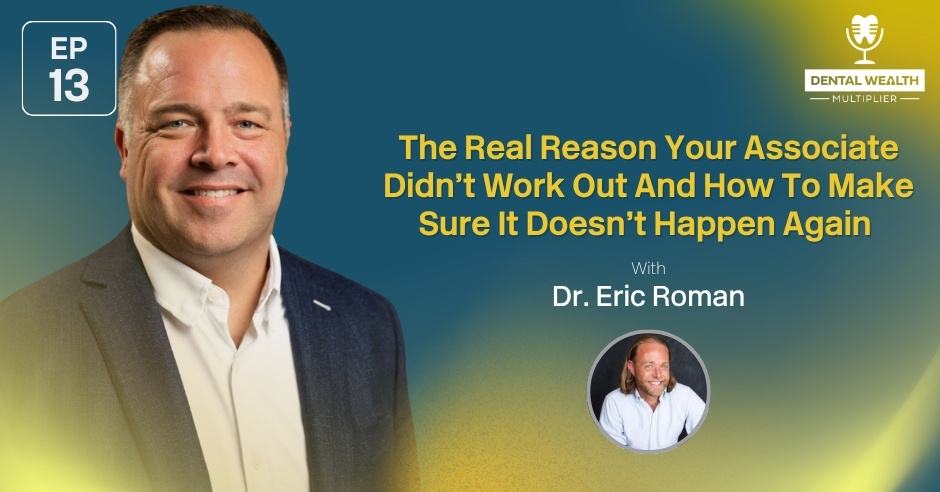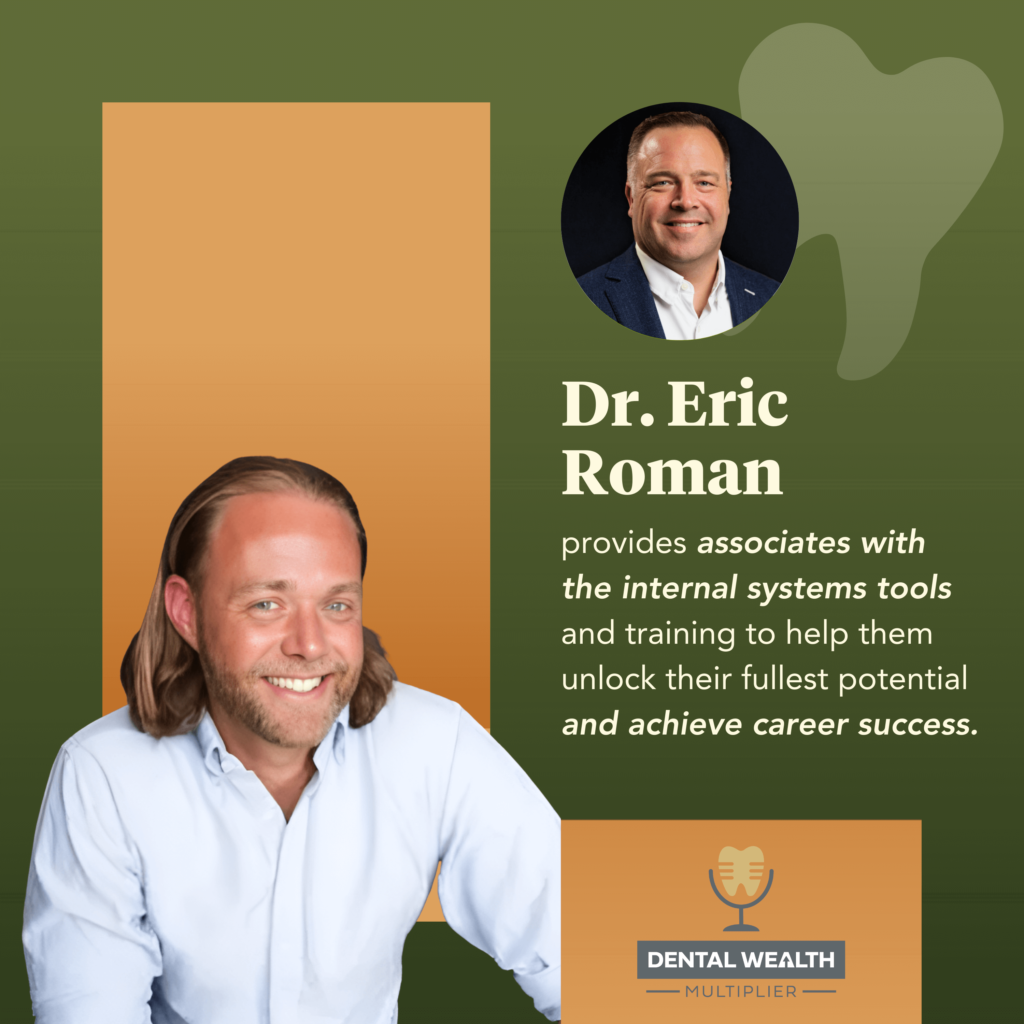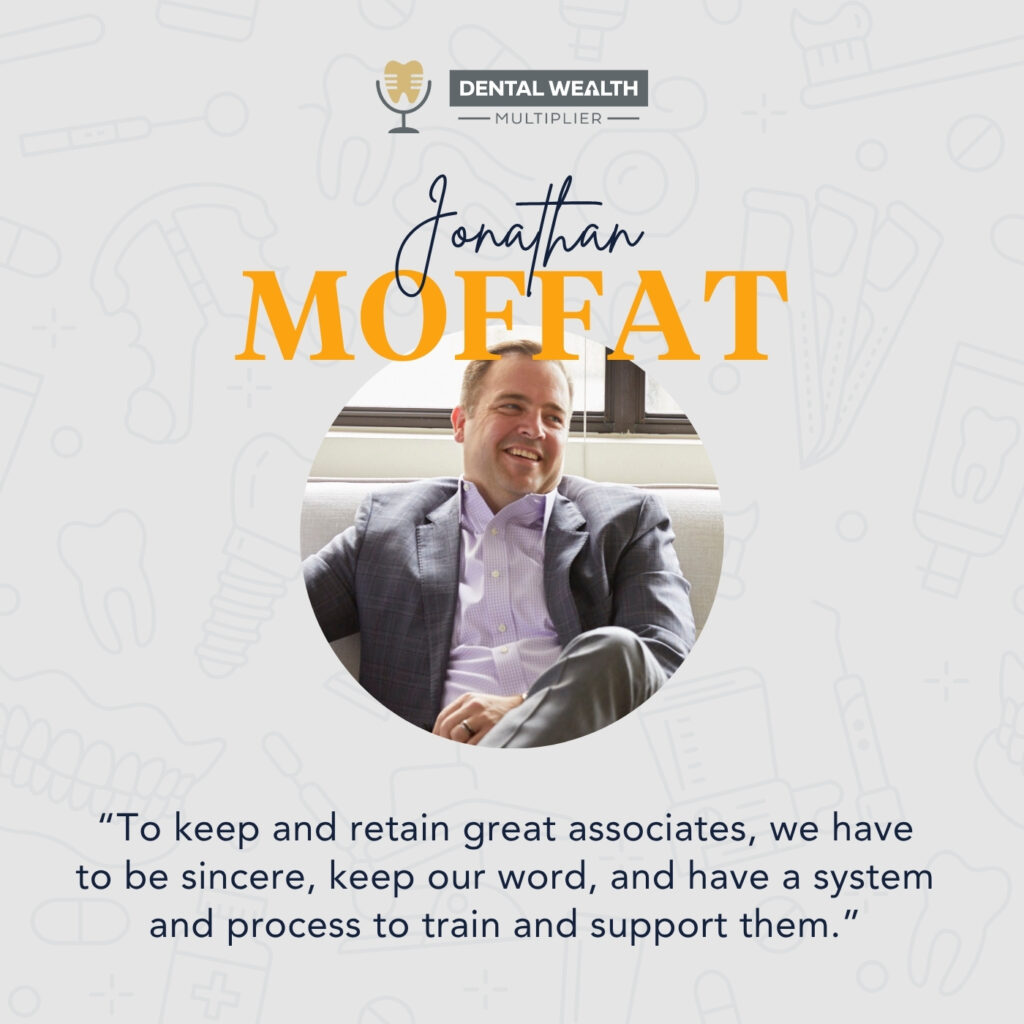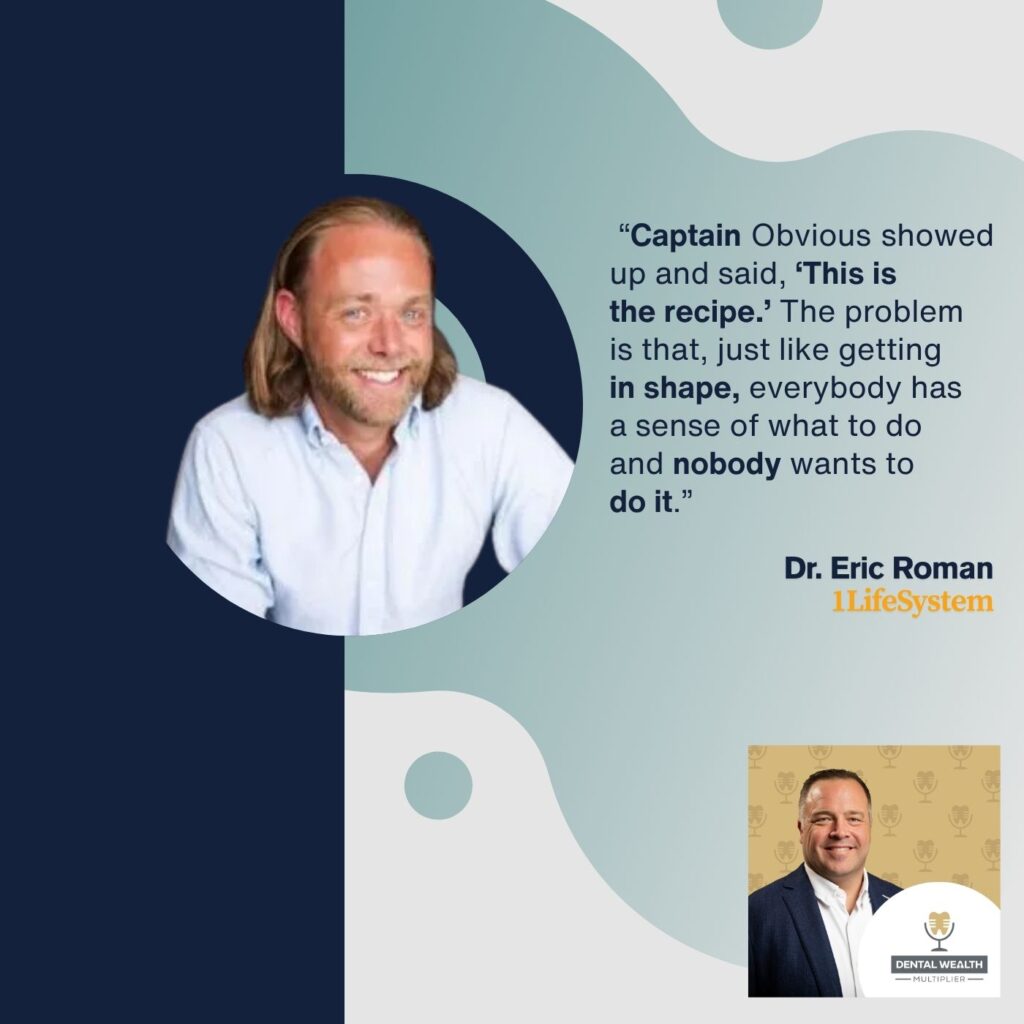
Jonathan Moffat is joined by Dr. Eric Roman to unpack why most associate relationships fall apart and why the problem often starts at the top. They break down the systems, expectations, and leadership habits that make or break associate success. Dr. Eric also presents his Dentist’s Playbook, a program specifically to help associates unlock their fullest potential. If you have ever been frustrated with an associate, this episode will challenge how you think and show you what to fix first.
Find Jonathan at jonathanmoffat.com
Learn more about Aligned Advisors at alignedadvisors.com
Connect with Dr. Eric Roman at drericjroman.com
Find Jonathan on LinkedIn: linkedin.com/in/jonathanmoffat1
Find Dr. Eric on LinkedIn: linkedin.com/in/drericjroman
New episodes weekly at dentalwealthmultiplier.com
—
Watch the episode here
Listen to the podcast here
The Real Reason Your Associate Didn’t Work Out And How To Make Sure It Doesn’t Happen Again With Dr. Eric Roman
How To Measure An Associate’s Effectiveness
If you’re sitting here, tuning in to this, and you’re like, “I either have an associate, and I’m struggling, or I’m on the fence about whether I should bring on an associate,” you have way more experience than I do. There is an owner looking at, “Is this associate cutting it for our team?” What are some of those things you’re looking at as the owner doctor? How are you making the decision of “I think we need to go a different direction here?”
First, we have to have a reasonable ramp-up period. Another way to describe this story that you said is that maybe you just got lucky on the second one. What if you had taken on the second one and it was worse than the first? The single biggest complaint of associates is not enough new patients or the wrong new patients. That’s my number one complaint that I get. When associates are done with my program, that is no longer their complaint. It’s a false understanding. Let’s look at the data. One of the key performance indicators that I am adamant about is measuring the total dollars diagnosed per exam and the total dollars accepted per exam.
It is not the percentage, but the total dollars. Why do I want to see that? It is because I want to know that every time doctor so-and-so does an exam, what are they seeing? What are people saying yes to? What you’re saying there, too, is that you have two doctors in here. Every time your normal doctor comes in, there’s going to be $1,000 accepted per patient. Now, you have the associate who, when they come in, it’s only going to be $200.
Why would you even let that associate see patients? Why would you even let them see your patients if they’re squandering the investment that’s there? Why is it that associates say, “I need more new patients?” It’s because what’s getting accepted per one is so low that they’re right. They would need a 5/1 ratio on your other doctor to be able to be as productive. It is a big issue. To answer the question, number one, let’s make sure we have an ample and appropriate ramp-up time. What are the expectations for month one productivity, month two, and month three? I feel like 90 days is enough time to get a good sense of how my relationship is going to go. I feel good about that.
The second thing is, what has to be true for me to know that I can work with this doctor? What are the expectations for what we’re going to be doing in our diagnostics and then in our case acceptance? I discovered that Dr. Jim Smith has been doing it this way for 28 years. He has been doing it. Jim doesn’t have a system for his diagnostics and case acceptance. I go in there. I look at it. I see a crown, three bridges, and whatever. Our new doctors don’t have systematic workflows inside their heads like that, nor do they have experience.

What is our system for moving them through diagnosis and case acceptance? What our doctors see is point number one: diagnosis and case acceptance. Their attitude and their approach to the game are my second criterion. What are they trying to accomplish? What’s their mindset and their attitude that they carry with them every day? The third thing that I look at is how they integrate and work with their team. How are they communicating with the team members? How are they doing with the hygiene team and with everybody that’s in there? How are they doing in huddles? Are they even showing up on time?
The fourth thing is clinical quality and clinical efficiency. It is sitting there and saying, “What are our clinical standards that they meet?” Those are the criteria that I use to measure the effectiveness of the doctor. If I’m not seeing movement, I’m also being open and honest. “Every other doctor in here right now is at this level with their diagnosis and their case acceptance. You’re at this level.” That’s usually where most people leave it. We’re like, “Work harder.”
What I’ve done is I built systems to sit there and say, “You’re here. They’re here. These are the things I need you to be doing and practicing on a regular basis to be able to move the needle. If you do, practice, and execute these things, the needle will move. Can you do that?” If they take that and they can’t move the needle, I’d say they’re not the right doctor. That’s maybe a long-winded, circuitous way to answer a complicated thing. It is attitude, diagnosis, case acceptance, the way they interact with the team, clinical quality, plus clinical efficiency.
It’s simple and complex because I draw parallels to getting in shape. It’s like going to get in shape. It’s pretty simple. Eat better, exercise, and eat well.
It doesn’t happen overnight.
You can complicate it. I’m not saying negatively either, but go get a blood test. Go get a DNA test. What’s my makeup? All those things and other aspects come into play. Business is the same thing. It’s funny. As you were talking, I thought of a client that we had. I’ll post his interview. I did a 30 or 40-minute interview with him a couple of years ago. He also spoke at one of our live events a few years ago. We also have that recorded as well, so I’ll post those in here somewhere. You guys can go watch if you want to.
What’s interesting is that he had a process. He had a process for onboarding associates. His process was that he would hire dentists right out of dental school. He’s like, “I only want them out of dental school. I don’t want them to be manipulated, changed, or have bad habits from another. I want them right out of dental school.” He’d hire right out of dental school. They would train with him one-on-one for 30 days. They would see patients, but he wouldn’t let them go on their own until they had trained with him for 30 days. They got a certificate of completion when they were done. “Congratulations. You’ve completed the doctor so-and-so clinical training.”
He sat with them. He had lunch with them. He’d go to dinner with them. He trained them for 30 days. They were his shadow. They videotaped a lot of the stuff. They had an archive of videos saying, “This is how we do this.” Eric, this isn’t going to surprise you, but it’s crazy. People don’t believe. They’re like, “There’s no way.” They hear him speak. They hear this interview and are like, “This guy is doing it.” Remember the operatories? They have twenty or so operatories. He’s got four associates. They do about $9 million a year out of that one practice. His associates, by the third month, are doing $90,000 to $100,000 a month.
How Clinical Autonomy And Quality Can Create Problems
That was it. That was my protocol. What I heard you say, Jonathan, is that he had systems that made it possible and easy for the doctors to succeed. That’s why I’m a systems guy. I create love and performance through systems. It begets an interesting question. Were the systems doing all the work? You know what was interesting? We had very few doctors who failed. We didn’t have many doctors who failed, coming into the system to hit our targets.
It was because the system was carrying a lot of that load. He had a rhythm. He had a company. He had a team. He had everybody who knew how to get results. The doctor had to do their portion. Follow the rules. Great point, Jonathan. Typically, in practice, we don’t have very reproducible systems on the clinical side, diagnosis, case acceptance, and productivity. We don’t have great systems there. “Jonathan, it’s because of clinical autonomy. I want to give everybody inside the practice all the clinical autonomy that they need to be able to.” What we are saying by that is, “I’m not going to follow, reinforce, or perpetuate best practices. I’m going to let everybody do whatever they want, even if it sucks.”
That’s what has become the definition of clinical autonomy. I want to know if I can use whatever composite I want. Why? You don’t need to. They’re all clinically acceptable. You’ll be fine, and you’ll figure it out. If you’re so anal-retentive that there’s only one composite that works for you, I don’t want to work with you. You don’t need to be inside somebody else’s practice. You have to be by yourself. Everybody wants to give clinical autonomy. Clinical autonomy is a lie. It’s a complete lie.
If everyone is given clinical autonomy, they will not follow, reinforce, or perpetuate best practices anymore. They will do whatever they want – even if it sucks. Share on XIt could just be an excuse, also.
I have said this on stage in front of thousands. I’ve said this for years. Dentists and associates, listen carefully. The more that we reinforce or talk about clinical quality, the less quality that person probably puts out. The more that somebody says, “All that matters to us is clinical quality,” ask me. I have hired triple digits. People who talked about quality the most had the worst. I’m saying it like it is. I’ve also heard from dentists that companies are like, “Everything here is about clinical quality.” No. They cut corners everywhere. Clinical quality is just what it means to be a dentist.
Training And Supporting Associates
I want to point out. I loved your point about getting in shape. Is there any question in America in 2025 about how you get in shape? No. You eat right, and you workout. It’s just that nobody wants to do it. Nobody sits there and says, “Eating right and working out would never work for me.” No, it’s just that I don’t want to eat right, and I don’t want to workout. That’s what it is. What is eating right and working out for a dentist? What is that, Jonathan?
For an owner dentist, I would say it’s creating systems and processes. It’s doing the work that no one wants to do. It’s also taking the time to sit down and get to know your team members and what’s important to them. You and I’ve had many conversations about this. They would say, “This doctor, these associates, all these DSOs are hiring associates. They’re offering relocation bonuses. They’re offering this and that.” Yes, but do you realize that on average, associates are only staying at those places for maybe 12 to 18 months, and then they’re moving on? That may attract them initially, but it doesn’t keep them there, versus sitting down.
You said this earlier. What is it that’s important to you? Where do you want to be in the next 1, 3, 5, and 10 years? Do you want to even own a practice? Yes or no. What’s your family situation? How much student debt do you have? Get in and talk to these doctors. It’s crazy. I’ll share this with you. I was driving back from a DSO meeting. I was on the phone with a client of mine. He’s got a wonderful practice in Louisiana. An associate wants to buy it. I’ve only met the associate a couple of times. This was interesting.
She texted me. She’s not my client. The senior doctor is my client, but she texted me. She went, “Jonathan, I need to talk to you. When do you have some time?” I said, “I have time. I’ll be driving back. I’ll have about 45 minutes in the car. Let’s talk.” I called her. She came on the phone. She completely opened up. I’ve had two conversations with her in my entire life. I was talking to my client. I was like, “Doctor so-and-so called me. We had a good conversation. We got deep. I heard some of her concerns and made some videos.”
He went, “It’s amazing that she opened up to you like that. She’s never had that conversation with me. I’ve worked with her for the last two years.” Why? I’m not going to sit here and pretend like I’m standing on a podium and I’m perfect with this. I’m sure if you had my team members on there, they would go, “Jonathan, you do the same thing.” I try to be better. I’ve tried to implement and practice a lot of these things. I certainly could be better.
Take the time, sit, listen, and create space where you’re not on your phone or your watch. Someone knocks, “Dr. Roman, patient is ready in room two when you’re ready,” and you’re, “Let’s get back to this conversation.” You have a dedicated time to sit down with people, invest, and learn about them. You will see what you’ll get in return, and my guess is that’s probably more important to them, or equally important than any monetary reward that you could offer, is that training.
How many times have I heard from associates, “I’m leaving this office because the doctor said that they would train me and mentor me. I’ve been here for two years, and it hasn’t happened once. I’m leaving this office because they talked to me about equity or profit sharing. That was five years ago. It’s never come up again since. When I brought it up last week, the doctor told me he didn’t have time to talk to me about it. I’m starting to think it’s never going to happen.” How many times have you heard those comments? I’ve heard them countless times.
It is immeasurable.
All it takes is sitting down. I tell our clients this all the time. “Sit down and have the conversation with them, and then have a plan in place.” Nine times out of ten, what the doctors or the associates want to hear is, “We have a plan. We’ve been there before. Even if we haven’t, we’re working with Dr. Roman. We’re working with John, who has a plan and has been there before. It’s important to us that we keep our word and that we help you achieve your goals as well, which is why we have this team, etc.”
That to me is something that is massively missing in this equation of how we keep and retain great associates. It’s be sincere, keep your word, and have a system and process to train and support them. It is just like you said. Make it easy for them to show up and learn what their strengths are. Some of our best doctors we had were like, “I knew day one.” I’m like, “This person should never hire, talk HR, or do anything like that. They’re so good with patients. Let’s just have them with patients.” You have to be able to understand and recognize that, and then let them succeed.

The minute you pull that away is when it’s not going to work out. They’re not going to be happy. You’re not going to be happy. You see a production drop. They’re probably going to leave. It’s a relationship. Just like any other relationship, it takes work. It takes an investment of time. It takes sitting down and having conversations with them. When’s the last time you sat down and had a conversation with your associate over lunch, dinner, or whatever to say, “How are you doing? How’s the family? What obstacles are you facing? How can I better support you to help you achieve your goals?” and just listen?
What I want to acknowledge for you, Jonathan, is that first, you were knocking it out of the park time and time again inside of there. Hence, the reason and what you pointed out is why you succeeded as a practice operator. You’ve got experience with it. It’s not your first rodeo. That’s why you succeeded. I’ve got to call it the way that it is. I’ve trained more clinical directors in dentistry than anybody. You’d be amazed how many times they’re like, “Yes, but Jonathan, I’ve got a lot of other stuff I need to do. I don’t want to do any of that. That takes time. I’ve got other stuff I want to do.” It’s almost like we’ve gone full circle. This is why we are where we are.
The recipe isn’t hard. It is taking good care of people, systems, coaching, oversight, communication, expectations, and accountability. Captain Obvious showed up and said, “This is the recipe.” The problem is that, just like getting in shape, everybody has a sense of what to do and nobody wants to do it. That’s the thing. I loved how you pointed out, too. There’s the diet and exercise for owners, which is different than diet and exercise for dentists. What is that? What’s funny about dentists is that they come into the industry and are like, “I’m good. I don’t need to do anything else. I don’t have anything I need to take care of or any of that sort.”

I’m like, “No, you should be doing diet and exercise every day and getting ripped as a dentist.” What does that mean? Full circle in that, it’s probably a nice pause point to sit there and say in this initial conversation, your point was, “Eric, why do we have a problem?” It’s because associates need to be doing “diet and exercise.” The people who take care of them need to be doing the same thing. Neither of them is. That’s why our associate turnover rates are 96% in less than eighteen months.
There is a model. We do have to acknowledge. There is the revolving door model. If you’re like, “I don’t care. I’ll just rip through associates every six months or every year. I’m just going to cut,” that also is a model, whether that’s a good model or a bad model. You can decide that, whether that’s the model you want or not, but that is a model. Don’t be surprised if that’s not the model you want, but you’re doing the things that would indicate, like what you said, “I don’t have time. We are busy. I can’t invest in my people,” you’re going to end up as a default. That’s what’s going to happen.
You’re going to have a hard time keeping, attracting, and retaining associates, or forget associates. You’re going to have a hard time attracting and retaining any high-quality team member if you’re not getting it. I’ve seen this time and time again. I saw this in a practice that used to be amazing. It has lost its entire team because the leadership in that particular practice has lost sight. There was a culture change. It was palatable, but that is a model. You need to decide whether that’s the model you want to have or not.
You hit the nail on the head. At the end of the day, everybody thinks it’s easy. Everybody thinks this is as easy as putting an associate in here and everything’s going to be fine. It’s not. If you think it’s hard to fire your front office, your assistant, or your hygienist, I need you to think about how hard it is to fire somebody who’s got a $600,000 debt load, making $200,000 a year, who’s been through hell. I hate to break it to you. It is harder to fire associates because you’re firing your peer group. I’m not saying this is the way it should be. I’m just saying it’s the way that it is.
It is harder to fire associates because you are firing your peer group. Share on XYou see why Eric Roman has committed his life to making the world better for associates and the people they work for. Whether that’s me directly training and reviewing associates or training the owner and clinical director to take great care of them and have all the systems, whatever it is, nobody has done that. It’s a nice little blue ocean that I’m happy to bathe in.
Dr. Eric’s Dentist Playbook
It’s badly needed in our industry, so why don’t you take us home with this? You’ve mentioned a couple of times. You have a training program. You said you have something coming up in June. Talk to us a little bit. What is that? Who is it for? What is it?
I do two things to solve this problem. The first thing that I do that’s active for the time being, until we do some branding work and pick a great name, we call it the dentist playbook. What I do there is I directly give the associates the internal systems tools and training that they need to be able to be successful. I can’t guarantee you that they’re going to use them, but we have an accountability system so that they can’t get away with it. Every 90 days, we’re doing an assessment and a review of those doctors. We’re giving them access to leadership training as well. It is the things they need to be doing.
You know what we talked about? It is diet and exercise. I’m showing them how to have a healthy body as an associate. We’re checking every 90 days to see how well they’re performing, tracking data, and all that sort. I do that for doctors and dental groups so that if you’re sitting there and you’re saying, “I wish somebody would work with my associate,” hi, I’m Eric Roman. Call me. I got this guy. That’s why we did it, because it was the lowest-hanging need and fruit.
The second thing that we’re doing, and where my real heart is, is sitting there and saying, “Do you want to be better at taking care of these doctors?” I’m not going to completely abdicate. You can’t abdicate your responsibility for meeting with them. You’ve got to hire them in the first place. You’ve got to build the scorecards and the key performance indicators.
You’ve got to set the expectations, the clinical standards, the hiring protocols, and the interview process. I built out all that with clinical directors and clinical leaders. If you want a program to build those things for you, with you, and install them in your company, that’s what we do. Our next group starts in June. If you want to find out more about that, you can hit me up at old DrEricJRoman.com. That’s our role, Jonathan.
I’m taking a stab in the dark. My guess is that if you develop that skill set and those processes and systems for dentists, they probably translate to hygienists, office managers, and other people in your base as well. This would be another good topic for us to dive into in another show. How do we leverage? Leverage is a funny word because it could imply “take advantage of,” and that’s not what we’re implying it to be. It’s how we maximize the people, the resources, that we already have? I guess it’s a skill set. I know who you are. I know the quality of work you put out, and they learn there. It’s going to translate directly across the board with all their other people on their team.
That’s exactly the idea. You nailed it. You hit it on the head. When you learn how to use these systems to create predictable outcomes, you’ll sit there and say, “I’m doing this with my doctors. I can do this.” The reason we’re doing it with your doctors first is because they’re 80% of your revenue. That’s why we’re doing it with them first. Honestly, we’ve had hygiene consultants forever to do a great job with that. Our hygiene consultants are awesome. They can solve that problem, hopefully, with good systems and hygiene. Nobody has done that with the docs. That’s my space.
Teach your systems to your doctors first. They are 80% of your revenue. Share on XGet In Touch With Dr. Eric
Eric, it is always fun. It is always a pleasure. This was a great topic. I’m glad we got to jump into it and hear your expertise. Everyone, thanks for sticking around and reading. Hopefully, you grabbed some nuggets. We’ll have some resources and some other stuff for you guys to read. Give us your website one more time, Eric.
It is DrEricJRoman.com.
It is like what’s written underneath your mug there.
It is easy-peasy. Thanks for having me, Jonathan. Bye.
Always. Bye.
Important Links
- Dr. Eric Roman
- Dr. Eric Roman on LinkedIn
- Jonathan Moffat
- Jonathan Moffat on LinkedIn
- Aligned Advisors
- Dental Wealth Multiplier
About Dr. Eric Roman
 Dr. Eric J. Roman started his professional journey as a dentist, but soon became the CEO of fast growing, multi-location dental groups that generated over $200m in care during his leadership. Eric strategically led his DSO through an exit in 2019, and chose to step out of DSO leadership to pursue a more balanced life.
Dr. Eric J. Roman started his professional journey as a dentist, but soon became the CEO of fast growing, multi-location dental groups that generated over $200m in care during his leadership. Eric strategically led his DSO through an exit in 2019, and chose to step out of DSO leadership to pursue a more balanced life.
His next growth phase came in the form of executive coaching and thought leadership, both inside and outside the dental industry. As one of the dental industry’s most esteemed experts on team dynamics, emerging DSO operations and associate dentist development, Eric spent several years coaching a community of more than $3B in annual revenue via the Dentist Entrepreneur Organization.
After his tenure at the DEO, Eric shifted his energy toward addressing an alarming trend: data is showing that, despite the success of our businesses, entrepreneurs and their teams are continually less fulfilled in their personal lives. To solve this, Eric developed the 1LifeSystem, a simple, recurring digital retreat that delivers personal fulfillment without sacrificing professional success. Whether it’s as a founder, operator, advisor, or investor, Eric loves to put his energy toward moving our industry forward.
